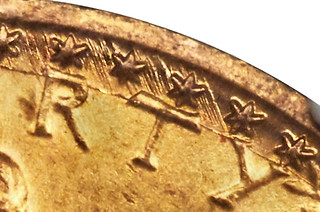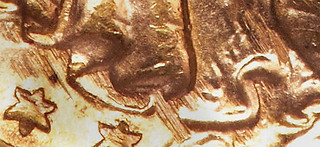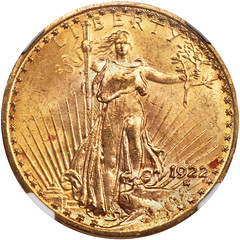
PREV ARTICLE
NEXT ARTICLE
FULL ISSUE
PREV FULL ISSUE
1922-S DOUBLE EAGLE “FILED DIE” VARIETY DISCOVEREDThis press release announces a new die variety in the U.S. $20 Saint-Gaudens Gold series. -Editor
1922-S Double Eagle “Filed Die”
Christened the “Filed Die” variety, it was first identified in January 2015 during detailed research for a pending Saint-Gaudens double eagle book. It took almost two years to locate a second specimen and have the variety certified by Numismatic Guarantee Corporation (NGC). This is possibly the most spectacular non-overdate die variety of the entire double eagle series, 1850-1933. The “Filed Die” variety has deep parallel grooves across parts of the obverse field. In places these are nearly as prominent as the rays. Deep file grooves extend across the central part of the coin and also are boldly apparent above the letters RT of LIBERTY and at the left base of Liberty’s skirt.
Was this a deliberate attempt to deface a die and prevent its use? Was it a wanton act of vandalism by a disgruntled employee? Was there some other reason that we can’t imagine? We’ll probably never know. My examination of San Francisco Mint records for 1922 disclose nothing unusual, so the best we can do is speculate. Discovery The process was to examine as many coins and high quality photos of coins as possible for every date and mintmark combination. This involved thousands of coins and in some instances, nearly every known specimen of very rare dates. Among the rare dates was 1922-S. With a mintage of 2,658,000 but an estimated survival of 2,100 pieces, most of which were low-end uncirculated, the coin is considered scarce except in MS66 condition. Ninety pairs of dies were used for double eagles at San Francisco in 1922 resulting in an average of 29,500 good coins per pair. Thus, the number of pieces from a single die pair was very modest. While searching through more than 300 individual coins in auctions and in-hand, I was able to locate one example of this variety by photograph-only. Without the physical coin, I did not consider this a true “discovery piece” although the variety was illustrated and described in my research notes. It was September 2016 when a second, unattributed specimen, was offered in Heritage’s September 11, 2016 internet action, lot #23744. I purchased the coin, which was graded by PCGS as MS64, and immediately asked that it be reviewed. This became the true “discovery coin.” It was not until December 2016 that NGC was able to examine the coin and record the variety. At this point the coin had been authenticated and was graded MS63 – a grade which I felt was reasonable. Auction Although I prefer to keep the coin and enjoy having a very special discovery piece, the economics of numismatic research do not permit that option. Description Survival Estimate Discussion Given the deep and very prominent grooves in the coin, it seems impossible that this would have been missed by die sinkers at the Philadelphia Mint. In fact, this dramatic variety is so unusual that the only points of comparison are with early U.S. gold and silver coinage where planchets were manually adjusted by filing across the face of the disc. There is no known mechanical, die production or handling reason for filing a working die in this manner. Thus, it must have been performed deliberately, possibly in an attempt to condemn a defective die, or as act of vandalism by an employee.  Wayne Homren, Editor The Numismatic Bibliomania Society is a non-profit organization promoting numismatic literature. See our web site at coinbooks.org. To submit items for publication in The E-Sylum, write to the Editor at this address: whomren@gmail.com To subscribe go to: https://my.binhost.com/lists/listinfo/esylum All Rights Reserved. NBS Home Page Contact the NBS webmaster 
|


